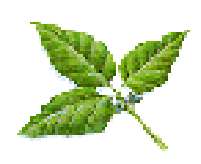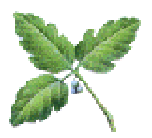|
|
Most of us have had the unpleasant experience of "Rhus" dermatitis
from poison ivy and/or poison oak or possibly from poison sumac. About 60-80% of
us are sensitive to the oily sap present in the roots, stems, leaves and fruit of
these plants. Most people develop symptoms within hours to one or two days. The
first symptom is severe itching of the skin. This is followed by redness and
blistering. In more severe cases, large blisters and localized swelling occur.
Severe cases may require hospitalization. The severity of symptoms vary greatly
depending on the amount of sap contacting the skin and individual sensitivity.
Although the dermatitis is extremely irritating, symptoms usually disappear in
about a week.
We come into contact with the oily sap when we bruise the epidermis (skin) of
these plants. Exposure tends to be worse in the spring and early summer when the
leaves are still tender. We can be exposed indirectly from contaminated clothing,
tools, sporting equipment such as fishing gear and golf clubs, and pets. We also
can be exposed when these plants are burned. This is the most serious form of
exposure with airborne sap-coated soot getting into the eyes, nose, throat and
respiratory system.
The sap has to penetrate the skin surface and bind with protein before
dermatitis can occur. After the antigen is fixed, it cannot be washed off or
transferred to other areas by scratching or oozing blister fluid. New blisters
represent less sensitive areas or areas where less sap was deposited. The most
severe poisoning affects areas with thin skin. Symptoms are less severe or do
not occur at all in areas with thick skin or heavy hair.
It only takes 10-15 minutes for the sap to penetrate the skin and bind with
protein. Therefore it is important to wash infected skin as soon as possible
with cold water to minimize the severity of the rash and prevent the spread of
the sap to uninfected parts of the body. Soap and water are superior to water
alone in removing the sap. Don't wash with solvents such as alcohol since they
tend to spread Rhus sap to unaffected areas.
Recognition
Recognition is important to avoid contact with these plants when possible.
It also is important so that sap can be removed from the skin as quickly as
possible after accidental contact with these plants has occurred.
Poison Ivy 
Either a small shrub or a vine trailing along the ground or climbing on low
plants, trees and poles. The leaves are alternate with three pointed and glossy
leaflets. The edges of the leaflets may be smooth or toothed, but they are rarely
lobed. They are reddish when they first emerge in the spring, are green during
the summer, and are various shades of yellow, orange, red, or bronze in the
autumn. Greenish-white flowers and whitish-yellow fruit in hanging clusters.
Poison ivy is found throughout the U.S. except along the western coast. Most
common in disturbed areas, edges of woods, flood plains, lake shores, stream
banks, along fences and around buildings.
Poison Oak
Similar to poison ivy except its three leaflets are lobed or deeply toothed with
rounded tips.
In the east, mostly restricted to sandy soil, dry barrens, sand hills, and
oak-pine or pine woods. In the west, in low places, thickets and wooded slopes.
Poison Sumac
A tall shrub or small tree with alternate leaves with 7-11 leaflets arranged in
pairs, and an additional single leaflet at the end of the midrib. Yellowish green
flowers and whitish green fruits hang in loose clusters.
Poison sumac grows in standing water in bogs, swamps and river bottoms. Most
common in the Great Lakes area, and eastern coastal plain.
Prevention
The best way to prevent Rhus dermatitis is to avoid contact with these plants.
If you think you might come into contact with them, wear a long sleeve shirt and
full length pants. If you have to handle poison ivy or its kin, wear impermeable
gloves. Remove and immediately wash clothing, gloves and boots or shoes in
detergent or soap.
Examples of commercially available products that seem to be effective in blocking
skin contact with the sap and removing the sap for two or more hours after
exposure are Armor® and Tecnu®, respectively. These products are
manufactured by Tec Laboratories. They are available at many pharmacies and shops
that cater to hikers and campers.
Treatment
Relief can be found through the application of medication available in most
drugstores. These include topical steroid creams and calamine-containing lotions
and salves that help dry the blisters. Severe rashes, especially those covering
large areas or accompanied by fever should be examined by a physician.
References
Human Poisoning from Native and Cultivated Plants, Hardin, J.W., and Arena, J.M., 1974, 2nd. Ed., Duke University Press, Durham, NC, 194 pps.
AMA Handbook of Poisonous and Injurious Plants, Lampe, K.F. and McCann, M., 1985, American Medical Association, Chicago, IL, 432 pps.
Health Information, National Center for Infectious Diseases, Centers for Disease Control and Prevention, Department of Health and Human Services.
If you have any questions, please contact a Regional Public Health Consultant, park sanitarian or call WASO Public Health for more information at 202-513-7226.
|

